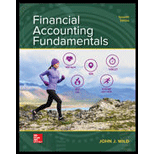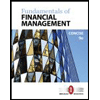
Concept explainers
It is the type of stock that company keeps with itself either by not issuing the shares or by buying back of shares.
Common Stock:
It shows the total amount of money that the owner has in this business. Owner use their right of being owner by voting for important matters in the general meetings of the company.
1.
To explain: Effects of buyback on corporation’s financial position.
Explanation of Solution
When an organization engaged itself in buyback, it reduces both the assets and the liabilities by the amount of buyback because to buy back its own share cash is used, which reduces asset and own stock bought is written with value 0 in the
Hence, buyback reduce both asset and liability by the same amount.
2.
To explain: Affect of buyback on corporation’s financial position.
2.
Explanation of Solution
- A company may buyback when it has extra equity then it requires because having more equity means paying to more shareholders even when you are not using their capital at all.
- A company may buy back its own equity when its share price falls for some bad news and can reissue when there is good news in the market and company’s share price is rising. In this way, company can earn extra money for their business without issuing any additional shares.
- A buyback is also increase the earning per share of the company because same profit is now divided among fewer shareholders.
Hence , a buyback can be done for number of reasons.
3.
To prepare:
3.
Explanation of Solution
Treasury stock is purchased.
| Date | Account Title and Explanation | Post ref | Debit($) | Credit($) |
| Oct 11 | Treasury Stocks | 13,400 | ||
| Cash | 13,400 | |||
| (Being treasury stocks is purchased ) |
Table (1)
- Treasury stocks are equity. Since, own equity is purchased, it reduces equity. Hence, credit Treasury Stocks account.
- Cash is an asset. Since, cash is used to pay dividend, it reduces asset. Hence credit Cash account.
a.
Treasury stocks reissued at cost price.
| Date | Account Title and Explanation | Post ref | Debit($) | Credit($) |
| Nov 1 | Cash | 13,400 | ||
| Treasury Stocks | 13,400 | |||
| (Being treasury stock issued at cost price ) |
Table (2)
- Cash is an asset. Since, cash is received, it increases asset. Hence debit Cash account.
- Treasury stock is equity. Since, shares is issued, it increases equity. Hence, credit Treasury Stock account.
b.
Treasury stocks reissued at $150 per share.
| Date | Account Title and Explanation | Post ref | Debit($) | Credit($) |
| Nov 1 | Cash | 15,000 | ||
| Treasury Stocks | 13,400 | |||
| Paid in capital in excess of par value, treasury stock | 1,600 | |||
| (Being treasury stock issued at above cost price) |
Table (3)
- Cash is an asset. Since, cash is received, it increases asset. Hence debit Cash account.
- Treasury stock is equity. Since, shares is issued, it increases equity. Hence, credit Treasury Stock account.
- Paid in capital in excess of par value, treasury stock is part of a shareholder’s fund. Since, money is received, it increases equity. Hence, credit paid in capital in excess of par value.
Working Notes:
Calculation of treasury stock,
Calculation of paid in excess of par value,
c.
Treasury stocks reissued at $120 per share.
| Date | Account Title and Explanation | Post ref | Debit($) | Credit($) |
| Nov 1 | Cash | 12,000 | ||
| Paid in capital in excess of par value, treasury stock | 1,400 | |||
| Treasury Stocks | 13,400 | |||
| (Being treasury stock issued at above cost price) |
Table (4)
- Cash is an asset. Since, cash is received, it increases asset. Hence debit Cash account.
- Paid in capital in excess of par value, treasury stock is part of a shareholder’s fund. Since, money is used, it decreases equity. Hence, debit paid in capital in excess of par value, treasury stock.
- Treasury stock is equity. Since, shares is issued, it increases equity. Hence, credit Treasury Stock account.
Working notes:
Calculation of cash,
Calculation of paid in excess of par value,
d.
Treasury stocks reissued at $120 per share.
| Date | Account Title and Explanation | Post ref | Debit($) | Credit($) |
| Nov 1 | Cash | 12,000 | ||
| Paid in capital in excess of par value, treasury stock | 1,000 | |||
| 400 | ||||
| Treasury Stocks | 13,400 | |||
| (Being treasury stock issued at above cost price) |
Table (5)
- Cash is an asset. Since, cash is received, it increases asset. Hence debit Cash account.
- Paid in capital in excess of par value, treasury stock is part of a shareholder’s fund. Since, money is used, it decreases equity. Hence, debit paid in capital in excess of par value, treasury stock.
- Retained earnings are a part of
stockholder’s equity. Since, stock is bought back, it reduces retained earnings account. Hence, debit Retained Earnings account. - Treasury stock is equity. Since, shares is issued, it increases equity. Hence, credit Treasury Stock account.
Working notes:
Calculation of cash,
Calculation of retained earnings,
e.
Treasury stocks reissued at $120 per share.
| Date | Account Title and Explanation | Post ref | Debit($) | Credit($) |
| Nov 1 | Cash | 12,000 | ||
| Retained earnings | 1,400 | |||
| Treasury Stocks | 13,400 | |||
| (Being treasury stock issued at above cost price) |
Table (6)
- Cash is an asset. Since, cash is received, it increases asset. Hence debit Cash account.
- Retained earnings are a part of stockholder’s equity. Since, stock is bought back, it reduces retained earnings account. Hence, debit Retained Earnings account.
- Treasury stock is equity. Since, shares is issued, it increases equity. Hence, credit Treasury Stock account.
Working notes:
Calculation of cash,
Calculation of retained earnings,
4.
To explain: Similarities and dissimilarities between previous entries.
4.
Explanation of Solution
Similarities
- It will lead to increase in the treasury stock by $13,400.
- Cash will always increase.
Dissimilarities
- Different amounts of paid in capital in excess of par value is used in part b, c and d for compensating fewer amounts received.
- Retained earnings is used in part e to compensate the fewer amount received in the entry.
- Except for entry a. In all the entries, treasury stock is issued at below cost price.
Hence, similarities are in cash and treasury stock there are dissimilarities is in amount and accounts used to compensate loss in issue.
Want to see more full solutions like this?
Chapter 11 Solutions
FINANCIAL ACCT.FUND.(LOOSELEAF)
- Horngren's Financial & Managerial Accounting: The Managerial Chapters, 8th Edition E-M:10-12 Making pricing decisions Sufyan Builders builds 1,500-square-foot starter tract homes in the fast-growing suburbs of Atlanta. Competition among developers is fierce. The homes are a standard model, with any upgrades added by the buyer after the sale. Sufyan Builders’ costs per developed sublot are as follows:Land $ 59,000Construction 124,000Landscaping 6,000Variable selling costs 5,000 Sufyan Builders would like to earn a profit of 14% of the variable cost of each home sold. Similar homes offered by competing builders sell for $208,000 each. Assume the company has no fixed costs. Questions:1. Which approach to pricing should Sufyan Builders emphasize? Why? 2. Will Sufyan Builders be able to achieve its target profit levels? 3. Bathrooms and kitchens are typically the most important selling features of a home. Sufyan Builders could…arrow_forwardCan you provide a detailed solution to this financial accounting problem using proper principles?arrow_forwardPlease explain the solution to this general accounting problem with accurate explanations.arrow_forward
- I am looking for the correct answer to this general accounting problem using valid accounting standards.arrow_forwardPlease provide the correct answer to this general accounting problem using valid calculations.arrow_forwardCan you solve this general accounting question with the appropriate accounting analysis techniques?arrow_forward
- I need the correct answer to this general accounting problem using the standard accounting approach.arrow_forwardI need help solving this general accounting question with the proper methodology.arrow_forwardI am searching for the accurate solution to this general accounting problem with the right approach.arrow_forward
- Donovan Manufacturing has an overhead application rate of 145% and allocates overhead based on direct material cost. During the current period, direct labor cost is$63,500 and direct materials used cost is $82,000. Determine the amount of overhead Donovan Manufacturing should record in the current period. Solutionarrow_forwardPlease explain the solution to this general accounting problem with accurate principles.arrow_forwardDuring June, the production department of a process operations system completed and transferred to finished goods a total of 82,000 units of product. At the end of May, 18,000 additional units were in process in the production department and were 70% complete with respect to materials. The beginning inventory included a materials cost of $92,400 and the production department incurred a direct materials cost of $276,800 during June. Compute the direct materials cost per equivalent unit for the department using the weighted-average method.arrow_forward
 Managerial AccountingAccountingISBN:9781337912020Author:Carl Warren, Ph.d. Cma William B. TaylerPublisher:South-Western College PubPrinciples of Accounting Volume 1AccountingISBN:9781947172685Author:OpenStaxPublisher:OpenStax College
Managerial AccountingAccountingISBN:9781337912020Author:Carl Warren, Ph.d. Cma William B. TaylerPublisher:South-Western College PubPrinciples of Accounting Volume 1AccountingISBN:9781947172685Author:OpenStaxPublisher:OpenStax College EBK CONTEMPORARY FINANCIAL MANAGEMENTFinanceISBN:9781337514835Author:MOYERPublisher:CENGAGE LEARNING - CONSIGNMENT
EBK CONTEMPORARY FINANCIAL MANAGEMENTFinanceISBN:9781337514835Author:MOYERPublisher:CENGAGE LEARNING - CONSIGNMENT Fundamentals of Financial Management, Concise Edi...FinanceISBN:9781305635937Author:Eugene F. Brigham, Joel F. HoustonPublisher:Cengage Learning
Fundamentals of Financial Management, Concise Edi...FinanceISBN:9781305635937Author:Eugene F. Brigham, Joel F. HoustonPublisher:Cengage Learning Financial Accounting: The Impact on Decision Make...AccountingISBN:9781305654174Author:Gary A. Porter, Curtis L. NortonPublisher:Cengage Learning
Financial Accounting: The Impact on Decision Make...AccountingISBN:9781305654174Author:Gary A. Porter, Curtis L. NortonPublisher:Cengage Learning





